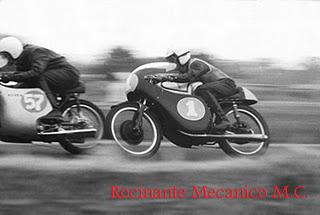Sunday, March 27, 2011
Friday, March 25, 2011
Thursday, March 24, 2011
Friday, March 18, 2011
Sunday, March 13, 2011
Sunday, March 6, 2011
Restoration Work---Carburetor Rebuild Part 2
It has been a while since Part 1 was written in large part due to the expanding scope of my restoration work. "Mission Creep", as the Army likes to call it, is the nemesis of any classic bike owner quickly transforming a simple fix into a major tear down. Despite being in deeper than I would like, I did finish putting the carburetor back together so I thought it would be a good time to pick up where I left off.
I alluded in Part 1 to the fact that the carburetor is the lung of the motorcycle. Carburetors depend on the venturi principle to accelerate air through its body to create a vacuum that vaporizes gasoline to form the combustion mixture. The elegant mechanism of jets, needle, and throttle slide all depend on the system being airtight. The same goes for the lung in which an air leak is termed a pneumothorax leading to compromised gas exchange even death.
Consequently, the first task during dismantling is the evaluation of all parts for wear that may lead to unwanted air leaks. Amal Carburetors are built from soft metals namely pot metal and brass and over time will wear. The photo below demonstrates a common wear pattern.
I alluded in Part 1 to the fact that the carburetor is the lung of the motorcycle. Carburetors depend on the venturi principle to accelerate air through its body to create a vacuum that vaporizes gasoline to form the combustion mixture. The elegant mechanism of jets, needle, and throttle slide all depend on the system being airtight. The same goes for the lung in which an air leak is termed a pneumothorax leading to compromised gas exchange even death.
Consequently, the first task during dismantling is the evaluation of all parts for wear that may lead to unwanted air leaks. Amal Carburetors are built from soft metals namely pot metal and brass and over time will wear. The photo below demonstrates a common wear pattern.
Throttle slide wear.
Notice that the wear pattern is eccentric. The inside of the carburetor body bears the same eccentric wear pattern; therefore, one cannot simply plop in a new slide. It's like fitting a circle into an oval and leads to an even bigger air leak than what you had before. This larger leak makes it impossible to tune the carburetor and probably explains the frustration many have with the Amal carburetor. The solution to this situation involves three options. The easiest remedy is just to buy a new carburetor. Buying new when one doesn't need to violates the central ethos of a classic motrocyclist and is an expensive proposition. It may also be impossible to find a new version of some of the rarer varieties. Recall from Part 1 that pre-monobloc carburetors within a certain type are not interchangeable. The code like 76AK/1AT fitted to my bike is a specifc combination of components of body and float bowl that vary in pitch, bore, and jetting. The other option is to ignore the situation and just put the old slide back and make due. In the middle is re-sleeving which in generic terms involves reestablishing the concentricity of the slide and body.
I opted for a solution that really isn't re-sleeving but a two-step process involving boring out the body round then making a stainless steel slide to fit the new bore of the carburetor body. An example of the slide is shown below:
The result is an airtight seal with enhanced durability thanks to the steel slide. My work was expertly done by Lund Machine and the throttle action is smooth as silk. At Lund Machine, they take your whole carb, clean it, modify it, and send it back at a pretty good price.
The other area of air leakage often overlooked is the junction of the carburetor to the manifold and manifold to the cylinder head. These mating interfaces need to be perfectly flat and generally suffer from years of mistreatment. This can be remedied by grinding both faces on a plate of glass with paste then fitting a new gasket. Resist the urge to reuse gaskets!! Also, don't over tighten the mounting bolts since that can lead to distortion ruining one's diligent work.
The other area that requires attention are the jets. Many enthusiasts clean jets with brass wire and the like but no matter how gentle one may be this changes the jet size. Over time, one inherits jets that are way out of specification leading to difficulties in tuning. I believe that all jets should be replaced with new ones. I would even go so far as to say that several different sizes should be purchased to take into account changes in gasoline formulation and sparkplug technology. A small variety of jets will provide the flexibility required to accurately adjust the carburetor settings. Fortunately, these adjustments are done in a stepwise fashion by component. Next time, I'll go through the mysteries of tuning the carburetor and we'll see the outcome. I promise that the next installment won't take so long.
Friday, March 4, 2011
Subscribe to:
Posts (Atom)











